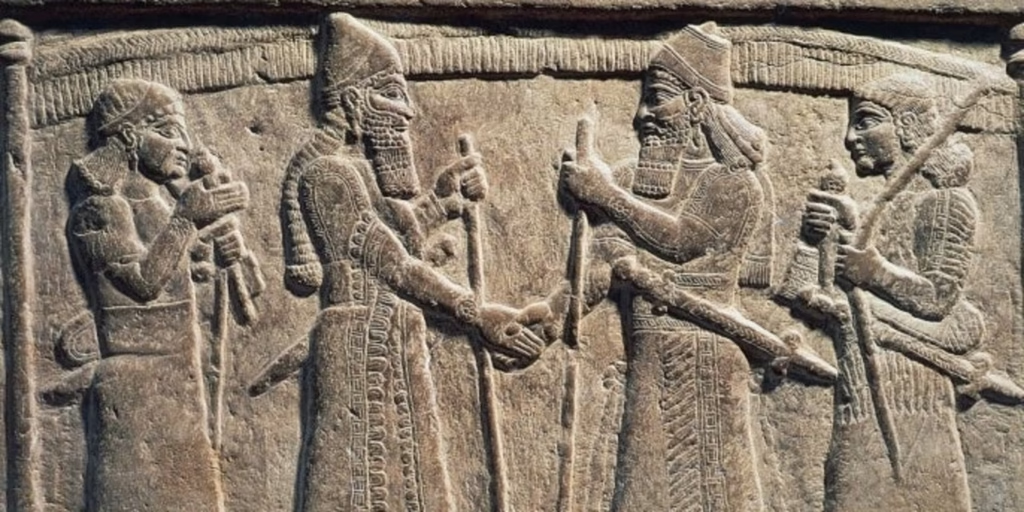The History of the Handshake: From Ancient Ritual to Global Gesture of Trust

The handshake is one of the world’s most recognizable and widely used social gestures. Though seemingly simple—a clasping of hands followed by a brief up-and-down movement—it carries deep cultural significance, signaling everything from peace and trust to equality and agreement. But where did the handshake originate? How has it evolved over time? And what roles has it played in different civilizations and historical moments?
This long-form brief explores the origins, evolution, symbolism, and cultural adaptations of the handshake from ancient times to its role in our modern, increasingly digital and health-conscious world.
Ancient Origins: A Symbol of Peace
The earliest evidence of the handshake can be traced back to ancient Mesopotamia, Greece, and Rome. Rather than a casual greeting, it often held profound symbolic meaning.
- Mesopotamian and Assyrian reliefs (dating back to the 9th century BCE) depict handshakes between rulers and deities, possibly symbolizing divine approval or mutual agreement.
- In Ancient Greece, the handshake (known as dexiosis) was seen in funerary art, symbolizing a final farewell or eternal unity between the living and the dead.
- Greek and Roman soldiers would shake hands or grasp forearms to show they were not concealing weapons, an action rooted in the concept of trust and non-aggression.
Thus, the handshake likely began as a gesture of peace, demonstrating that the hand—an instrument of war—was empty.
Medieval and Renaissance Europe: Trust and Brotherhood
During the Middle Ages, the handshake was not a common civilian greeting but was often used in more formal and symbolic contexts:
- Knights and noblemen would clasp each other’s forearms to prove they weren’t hiding daggers in their sleeves.
- In legal and commercial agreements, handshakes became part of sealing contracts and oaths before formalized signatures were common.
- In certain Christian traditions, a ritualized handshake (the “kiss of peace” or “holy kiss”) evolved into a handshake as a sign of spiritual brotherhood.
During the Renaissance, handshakes began to represent equality and mutual respect, especially among men of similar social rank.

The Handshake as a Modern Greeting
The widespread use of the handshake as a general greeting, especially in Western cultures, emerged around the 17th and 18th centuries, gaining prominence among Quakers in England and America.
- Quakers promoted the handshake as a symbol of equality, rejecting bowing and tipping hats, which they viewed as hierarchical.
- By the 19th century, the handshake had become a normative greeting in business and diplomacy, symbolizing openness and honesty.
- It was also adopted across military ranks, serving as both a greeting and an expression of loyalty.
Global Spread and Cultural Variations
While the handshake became dominant in Western culture, not all societies traditionally used it. Some cultural alternatives include:
- Bow (Japan) – A respectful gesture emphasizing hierarchy.
- Namaste (India) – A palm-pressed gesture symbolizing inner peace and reverence.
- Cheek kisses (Southern Europe, Latin America) – A familiar and affectionate greeting.
- Hand-on-heart or nose rubbing (Middle East, Inuit cultures) – Non-contact or culturally unique gestures.
However, globalization and Western influence led to the adoption of handshakes in international settings—especially in business, politics, and diplomacy.
Iconic Handshakes in History
Certain handshakes have symbolized turning points in history:
- Richard Nixon and Zhou Enlai (1972) – U.S.-China diplomatic thaw.
- Yitzhak Rabin and Yasser Arafat (1993) – Oslo Accords, mediated by Bill Clinton.
- Nelson Mandela and F.W. de Klerk (1990s) – Signaling the end of apartheid.
- Barack Obama and Raúl Castro (2013) – Gesture of reconciliation between the U.S. and Cuba.
These handshakes were often choreographed yet powerful symbols of peace and diplomacy.
The Handshake in the Age of Germs and Technology
The COVID-19 pandemic in 2020 disrupted the centuries-old custom of the handshake:
- Concerns about viral transmission led to alternative greetings such as elbow bumps, head nods, and foot taps.
- Public health experts questioned whether the handshake would survive in a more germ-conscious society.
- Despite this, the handshake has gradually returned in many cultures post-pandemic, though with more awareness around hygiene.
In the digital age, handshakes are also symbolically present in emojis, online deals, and even blockchain-based “digital handshakes”, showing how the gesture evolves with technology.
The Psychology of the Handshake
Studies in psychology show that a firm, warm handshake:
- Creates positive first impressions
- Conveys confidence and sincerity
- Can increase trust in negotiations and interviews
However, cultural nuances matter—grip strength, duration, and eye contact vary significantly by region and context.
The Future of the Handshake
Will the handshake endure?
- Many experts believe it will persist as a symbolic gesture in diplomacy, business, and formal events.
- However, it may decline in casual or informal settings, replaced by culturally appropriate alternatives.
- Hybrid models—like contactless greetings combined with verbal affirmations—may become the new norm.

Conclusion
The handshake is more than a greeting—it is a historical, cultural, and psychological tool for establishing trust, equality, and human connection. From ancient warriors proving peaceful intent to diplomats forging peace treaties, the gesture reflects our deepest social instincts.
Whether clutched in solemn ceremony or exchanged in a casual meet-and-greet, the handshake remains one of humanity’s oldest and most meaningful rituals—a simple yet profound touch across time, cultures, and civilizations.




